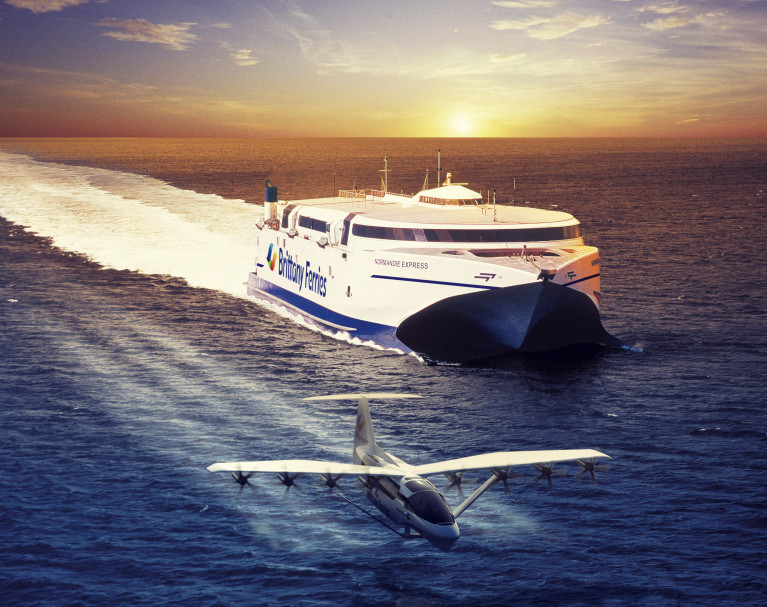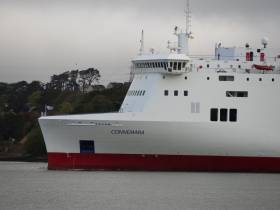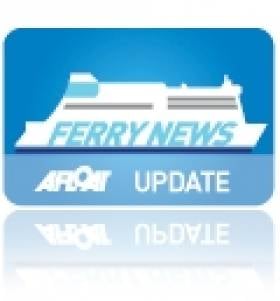Displaying items by tag: Britanny Ferries
Brittany Ferries is exploring the potential for a new high-speed, sustainable and more efficient form of ferry travel called a seaglider.
The concept, an all-electric, wing-in-ground effect vehicle (WIG), is under development in the United States through Boston-based start-up REGENT (Regional Electric Ground Effect Nautical Transport).
Brittany Ferries has signed a letter of intent which could see seagliders with a 50-150 passenger capacity sailing between the UK and France by 2028. REGENT expects the first commercial passengers to travel on smaller electric craft by 2025.
Seagliders combine the convenience of passenger ferries with the comfort of hydrofoils, the aerodynamic efficiency of hovercraft and the speed of aircraft. With the potential to connect existing ferry ports, the craft are expected to fly at speeds of up to 180 mph – six times faster than conventional ferries – with a battery-powered range of 180 miles.
The voyage from Portsmouth to Cherbourg, for example, could be covered in as little as 40 minutes.
They work by harnessing a concept well-known to pilots – ground effect. This is the cushion created by high-pressure air trapped between wings and the ground or water while flying at low altitude. Seagliders are therefore akin to a hovercraft with wings, rather than a skirt.
Following departure from port, the craft rises on foils insulating passengers from wave discomfort. In open waters, it takes off, riding the air cushion all the way to its destination. Wing-mounted propellors provide the thrust to take to the air at low speeds, while electric motors regulate air flow over wings while riding the air cushion.
It’s a highly efficient mode of transport, capable of moving significant loads over long distances at high speed. Power will come from batteries rather than fossil fuel. Flight safety comes courtesy of redundant propulsion and flight control systems, with next-generation sensor suites detecting and automatically avoiding traffic at sea.
Energy transition is a priority for forward-looking companies like Brittany Ferries and is key to its recovery post-Covid. Based in Roscoff France, the company has already invested in the delivery of two new LNG (liquefied natural gas) ships for delivery in 2022 and 2023 called Salamanca and Santoña*.
Its partnership with REGENT goes one step further. It is a visionary project which offers an exciting glimpse into the future, the kind of vehicle never before seen in Franco-British waters. Brittany Ferries is contributing to development discussions, as the company has a track record in operating fast ferries such as Normandie Express (currently chartered to Condor Ferries).
“Seaglider is an attractive and exciting concept and we look forward to working with REGENT in the months and years to come,” said Frédéric Pouget, ports and operations director for Brittany Ferries. “We are particularly pleased to contribute now because it means we can bring real-world challenges and potential applications into the company’s thinking at an early stage. We hope this may help bring commercial success in the years that follow. Who knows; this could be the birth of ferries that fly across the Channel.”
Billy Thalheimer, co-founder and CEO of REGENT, added “REGENT is excited to partner with Brittany Ferries to bring the future of maritime transportation to market. Brittany Ferries offers world-class operational experience which will help REGENT ensure that our seagliders will be the most convenient and comfortable form of cross-Channel travel.”
REGENT is working on several different sizes of passenger-carrying seagliders, all of which operate on the same principle. Operating a few meters above the water’s surface, they combine the high speed of an aeroplane with the low operating cost of a ship. It has the potential to serve routes of up to 180 miles with existing battery technology, and routes up to 500 miles with next-generation batteries.
Both Brittany Ferries and REGENT understand that many technological, practical and regulatory milestones lie ahead. However, both companies say that caution should not stand as an impediment to the development of a promising concept that already has a history in military applications and smaller leisure craft operating around the world. Both companies look forward to the promise of cross-channel services, reduced emissions, and seagliders becoming commonplace.
For like electric cars, seagliders automatically become greener as more source electricity is generated from renewable sources. And thanks to the inherent efficiency of travelling above water, speed need not be sacrificed to help lower emissions, slow-steaming being one of the solutions proposed for traditional sea-going vehicles to limit environmental footprint.
*investment made in years before current Covid-19 crisis
Europe Day: Sees Start of Historic New First Ever Direct Ireland-Spain Ferry Route Service
#FerryNews - Europe Day aptly coincided with Brittany Ferries albeit delayed start of the first ever direct Ireland-Spain ferry service when Connemara departed Cork at lunchhour today bound for Santander, writes Jehan Ashmore.
Almost berthed adjacently to Ringaskiddy Ferry Terminal where ropax Connemara welcomed passengers and loaded vehicles for today's historic maiden voyage to Spain, was docked Portuguese flagged cruiseship Astoria. The veteran vessel had arrived earlier this morning.
As for the ferry, Connemara had also arrived this morning from France (see below) before launching the new historic continental route directly connecting Ireland and Spain for the first time. A scheduled departure at 11.00 did not take place however the ropax finally was underway two hours later. Connemara then past Roches Point Lighthouse at the mouth of Cork Harbour and out into the open sea.
Connemara, formerly Asterion is on a two-year charter to Brittany Ferries which are to operate the 2007 Italian built Cypriot flagged ropax across the Bay of Biscay service on a trial basis. The 500 passenger /120 cabin ferry is modelled on a économie 'no-frills' service that is scheduled to run two return sailings weekly between Cork and northern Spain.
Crossing times on the 27,000 gross tonnage Connemara connecting Cork and the Cantrabrian port is around 26 hours. Facilites available of the no-frills operated ferry include a self-service restaurant, café/bar, small shop / boutique and seating lounge. In addition to en-suite cabins for passengers that are exclusively motorist-based. The ropax can handle a mix of around 100-freight trailers units and between 80 and 100 tourist vehicles.
Traveling direct to Spain now offers exciting benefits for Irish tourists to explore the lesser known regions of northern Spain compared to air-dependent destinations to the countries Costa's lining the Meditteranean. It is from these well-trodden resorts where around 2 million Irish holiday-makers annually visit the coast but rarely travel to the interior. Now there's northern Spain, where Santander itself is a culinary destination, Bilbao beckons (for Leinster rugby fans on board) as does the Basque Country and regions heading west to Galicia neighbouring Portugal.
The new Irish-continental link will further forge in strengthening travel and cultural ties with Spain but throughout the Iberian peninsula. In addition to assisting existing and developing new freight trade opportunities.
According to the Port of Cork, which has been trying to open an Ireland-Spain link since 2004, the service will remove 1,200kms off road journey distances for many hauliers currently opting for a land-bridge via the UK. The new Spanish service is a also a game-changer given a post-Brexit UK and its relationship between Ireland and with the rest of the EU.
Prior to today's historic maiden voyage on the Ireland-Spain route, Connemara's debut for Brittany Ferries was completed following a sailing to France yesterday. This morning, Connemara returned to Ringaskiddy to complete the round trip. Due to operational reasons, the 186m Connemara docked in Brest rather than the routine port of call at Roscoff.
The Ireland-France route which this year celebrates a 40th anniversary, is served by flagship cruiseferry Pont-Aven at the weekends. Introduction also of Connemara during the week boosts capacity and likewise of the Spanish service is based on an économie no-frills service, except foot-passengers are catered for on the 14 hour Iink to Roscoff.
Brittany Ferries 'Flagship' Sets Sail for Summer Season
#FERRY TO FRANCE – Brittany Ferries flagship Cork-Roscoff route is underway, as the first sailing in 2012 of the seasonal-only operated service started last weekend and runs to early November. Serving on the 14 hour route which is the shortest sailing to France, is the luxurious flagship Pont-Aven, writes Jehan Ashmore.
The 2,400 passenger /650 vehicle capacity Pont-Aven is unique to Irish services as she features a swimming pool. The indoor facility located on the top deck, includes a leisure area and pool bar which is open during the summer season and on busy off-season crossings.
In addition there are restaurants, a piano bar, main lounge, café and shop facilities. She has a wide choice of cabin accommodation that includes 'Commodore' cabins complete with balconies. For details about sailing schedules click HERE.
Roscoff is set in picturesque surroundings on the north-west Breton coast and the ferryport is a short distance even by foot to the town which has restaurants facing the coast. There is a botanical garden and a century-old thalassotherapy that has seawater and seaweed treatments used for healing and relaxation therapies.































































